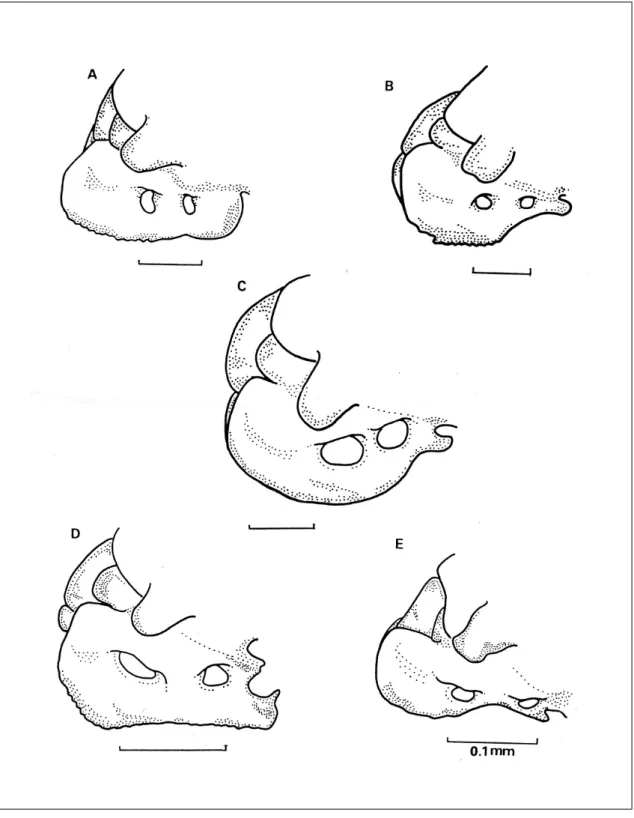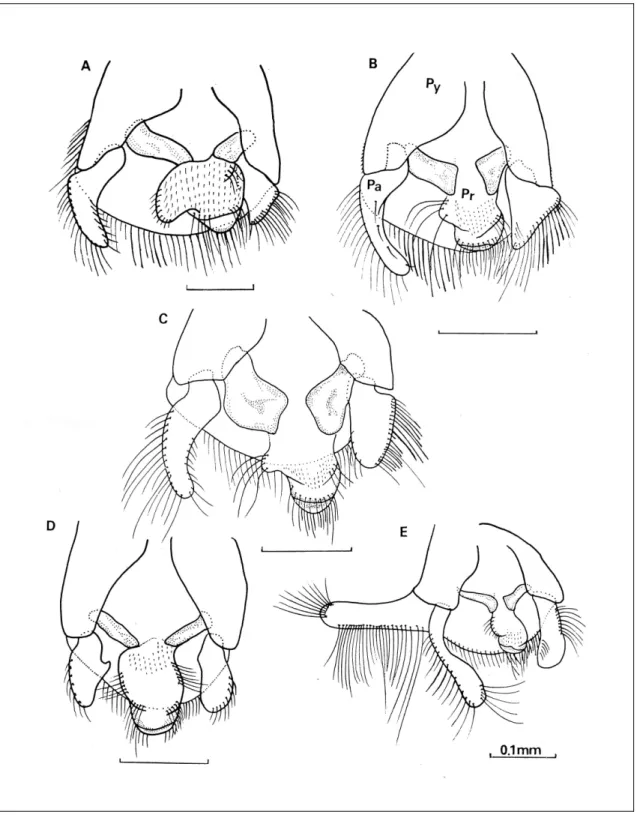研究報告
έ៉ٿᖪ 23: 27-34 (2003) Formosan Entomol. 23: 27-34 (2003)Introduction
Due to there being smaller groups of semi-aquatic insects, the insect fauna of the family Hebridae, velvet water bugs, is poorly known in Taiwan. Because of their small size and difficulty of field collect, just a few taxonomic papers have focused on them, only two genera of Hebrus Curtis and Timasius Distant have heretofore been recorded in Taiwan. The Genus Timasius Distant comprises 16 species (Miyamoto, 1965; Andersen, 1982; Zettel, 1998), distributed in India, Sri Lanka, and Southeast Asia. According to Miyamoto (1965) and Zettel (1998), there are four species, T. distanti Miyamoto, T. minamikawai Miyamoto, T. lundbladi Miyamoto, and T. wangi, in Taiwan. In this paper, one speices, T. miyamotoi Andersen, 1981, is recorded as new to Taiwan, so there are totally five species recorded.
Hebrids are one of the smallest
members within the Gerromorpha, ranging from 1.3 to 4.1 mm, with Timasius usually exceeding 3 mm. The body has dark brown to black coloration, and is almost entirely covered with micro- and macrohairs. The head of Timasius is elongate, and is distinctly extended before the eyes. The antennae are 4-segmented with a constriction and false joint structure in the middle of the 4th antennal segment. Ventral lobes of the head are prominent and continue posteriorly along the ventral margin of the head in a pair of bucculae. Two basal cells of the forewing are delimited by a slender anal vein (1A). The paired, longitudinal carinae of thoracic venter converge to join before the hind margin of the metasternum. The metanotal elevation is triangular, and it medially keeled and pointed. The proctiger of the male is usually simple and elongate. Parameres are somewhat asymmetrical.
Specimens were collected by hand-
Males of the Genus Timasius Distant (Hemiptera: Hebridae) of
Taiwan
Te-Pin Chang and Ping-Shih Yang* Department of Entomology, National Taiwan University, Taipei, Taiwan 106, R.O.C.
ABSTRACT
Five species of the Genus Timasius Distant from Taiwan are recognized. Among them, one speices, T. miyamotoi Andersen, 1981, is recorded as new to Taiwan. Bucculae and male genitalia are described and illustrated. A key to the species from Taiwan is also included.
nets and aspiration near humid terrestrial or marginal aquatic habitats, on floating plants or on the water surface near the shore throughout Taiwan. Specimens were sorted and preserved in 75% alcohol. Representative specimens of each taxon were mounted on glass slides with Canada balsam using ordinary procedures.
Key to Taiwanese species of the genus Timasius (modified after Andersen, 1982)
1. Male left paramere small, rounded ---T. miyamotoi - Male left paramere large, elongated -- 2 2. With long, spinelike pygophore process --- wangi - Without pygophore process --- 3 3. Posterior part of buccula simply
rounded --- distanti - Posterior part of buccula tapering in
width to a small tooth --- 4 4. Male abdominal venter with a distinct oval depression, with hairs on sternum 3-7 --- minamikawai - Male abdominal venter not depressed,
but flattened --- lundbladi
Descriptions
1. Timasius distanti Miyamoto, 1965
Timasius distanti Miyamoto, 1965, Sieboldia 3: 281-294.
Male:
Head and body black or dark brown. Antennae brownish yellow, bucculae pale, rostrum pale brown. Hemelytra dark, with an elongate grayish marking on each corial cell; membrane blackish on apical half. Legs pale brown on 3 basal segments, dark or blackish brown on tibiae and tarsi; femora darkened at apex, with scattered dark spots. Thoracic venter covered with grayish hairs, abdominal venter with pale brown hairs.
Buccula tall, with 2 small depressions; buccula process rounded on hind end; eye width: interocular = 0.65: 1;
antenna length: body length = 0.57: 1; paired carinae on pronotum low; lengths of pronotum: mesoscutellum: metanotal elevation = 5.3: 1: 3.
Pygophore short, with bristles, with moderatly bristled process on left side; proctiger small, asymmetrical, with a large process on left side; left paramere long, with long hairs on left side and bristles on right side; right paramere rather small, with long hairs.
Measurements (in mm): Length of body
3.30-3.85; width between humeri 1.25- 1.60; length of antenna 1.95-2.20.
Distribution: Taiwan
Materials examined: CHIAYI: Fenchifu,
1♂ 5♀, 31-III-2000; Alishan, 3♂ 4♀, 30-IV-2000, T.P. Chang. ILAN: Shuang- lianbei, 6♂ 2♀, 29-III-2000, T.P. Chang. NANTOU: Jioufenershan, 2♂, 18-IX-2001, T.P. Chang; Puli, 1♂ 2♀, 7-VI-2001, T.P. Chang. TAICHUNG: Takeng, 5♂ 1♀, 23-IV-2000, T.P. Chang. TAIPEI: Shilin, 1♂ 2♀, 4-IX-2000, T.P. Chang; Yang- mingshan, 1♂ 3♀, 23-VIII- 2000, T.P. Chang; Wulai, 2♀, 21-VI-2001, T.P. Chang. TAOYUAN: Mingchih, 1♂ 3♀, 12-VII- 2000, T.P. Chang; 7♂ 5♀, 13-VIII-2000, T.P. Chang.
Remarks: This species is easily
separated from T. minamikawai and T. lundbladi by the posterior part of the buccula which is simply rounded and does not taper in width to a small tooth. 2. Timasius lundbladi Miyamoto, 1965
Timasius lundbladi Miyamoto, 1965, Sieboldia 3: 281-294.
Male:
Head and body brown to dark brown. Antennae yellowish, bucculae yellowish, rostrum lighter brown. Hemelytra brown, with an elongate pale bluish- gray marking on each corial cell. Legs pale yellow on 3 basal segments, brownish on tibiae and tarsi.
Buccula tall, toothlike, with 2 small rounded depressions; buccula process reduced on hind end; eye width:
interocular = 0.8: 1; antenna length: body length = 0.68: 1; lengths of pronotum: mesoscutellum: metanotal elevation = 4.8: 1: 3.2.
Pygophore short, with bristles, with moderately bristled process on left side; proctiger small, asymmetrical, with a moderated process on left side, furnished with 4 basally flattened bristles; left paramere long, somewhat strongly curved, with long hairs on left side and a few bristles on right side; right paramere small, with long hairs.
Measurements (in mm): Length of body
2.65-2.95; width between humeri 1.05- 1.35; length of antenna 1.75-2.05.
Distribution: Taiwan
Materials examined: CHIAYI: Fenchifu,
12♂ 4♀, 31-III-2000, T.P. Chang; Kuantyling, 4♂ 2♀, 1-IV-2000, T.P. Chang. HUALIEN: Wenshan, 2♂ 1♀, 27-VII-2000, T.P. Chang. KAOHSIUNG: Liukuei, 3♂ 5♀, 25-V-2000, T.P. Chang. PINGTUNG: Hsuhai, 3♂ 2♀, 4-VIII-2000, T.P. Chang. TAOYUAN: Mingchih, 2♂ 1♀, 13-VII- 1999, T.P. Chang. YUNLIN: Touliou, 2♂, 19-VIII-2000, T.P. Chang; Tsitung, 9♂ 4♀, 22-VIII-2000, T.P. Chang.
Remarks: This species is easily
separated from all others by its smaller body. It is very similar to T. minamikawai, but can be separated by the abdominal venter of the male along the median line flat not depressed and the left paramere being curlier than that of T. minamikawai.
3. Timasius minamikawai Miyamoto, 1965
Timasius minamikawai Miyamoto, 1965, Sieboldia 3: 281-294.
Male:
Head and body dark brown to black. Antennae pale yellow, bucculae yellowish, rostrum lighter brown. Hemelytra lighter brown, with an elongate pale bluish-gray marking on each corial cell. Legs brownish on 3 basal segments, tibiae and tarsi; femora with dark spots.
Buccula with lower margin broadly round and posterior end produced below, forming a small lobe; eye width: interocular = 0.65: 1; antenna length: body length = 0.60: 1; paired carinae on pronotum obscure; lengths of pronotum: mesoscutellum: metanotal elevation = 6.7: 1: 3.5.
Abdominal venter with a distinct oval depression. Proctiger large, asym- metrical, furnished with 3 basally flattened bristles on right side; left paramere large, gently curved, with long hairs; right paramere rather small, with hairs.
Measurements (in mm): Length of body
3.05-3.15; width between humeri 1.30- 1.42; length of antenna 1.80-1.95.
Distribution: Taiwan
Materials examined: ILAN: Shuang-
lianbei, 1♂ 3♀, 15-V-2000, T.P. Chang. PINGTUNG: Suchungchi, 2♂, 9-VIII-2000, T.P. Chang; Nanjenshan, 1♂, 10-VIII-2000, T.P. Chang. TAICHUNG: Shihgang, 3♂, 13-VI-2001, T.P. Chang. TAIPEI: Hsuanchi, 1♂, 3-V-2000, T.P. Chang; Pingshi, 3♂ 1♀, 12-VIII-1999, T.P. Chang. TAOYUAN: Lungtan, 2♂ 4♀, 13-VII-1999, T.P. Chang; Mingchih, 5♂ 3♀, 13-VII-1999, T.P. Chang; 2♂ 1♀, 12-VII-2000, T.P. Chang.
Remarks: This species is easily
separated from T. distanti by the smaller body, shape of the bucculae; and from T. lunbladi by an oval depression on the abdominal venter and the structure of the paramere.
4. Timasius miyamotoi Andersen, 1981
Timasius miyamotoi Andersen, 1981, Syst. Entomol. 6: 377-412.
Male:
Head and body black. Antennae brownish yellow to pale, bucculae dark brown, rostrum brown. Pronotum mainly black, hemelytra dark, with an elongate grayish marking on each corial cell. Legs brown on 3 basal segments, dark brown on tibiae and tarsi; femora dark at apex.
Thoracic venter covered with golden hairs, abdominal venter with brown hairs.
Buccula large, toothlike, with 1 ovate and 1 circular depression, posterior end with 2 blunt processes; eye width: interocular = 0.63: 1; antenna length: body length = 0.61: 1; paired carinae on pronotum very low; lengths of pronotum: mesoscutellum: metanotal elevation = 4.5: 1: 5.3.
Pygophore with short bristles; proctiger almost symmetrical, qua- drangular, hind margin slightly produced; parameres subequally long, with blunt lateral processes, with moderate hairs medially and subapically.
Measurements (in mm): Length of body
3.00-3.20; width between humeri 1.10- 1.35; length of antenna 1.77-1.92.
Distribution: Taiwan (new record) and
Hong Kong.
Materials examined: KAOHSIUNG:
Tengchih, 2♂, 18-V-2000, T.P. Chang. TAITUNG: Lanyu, 3♂ 1♀, 7-IX-2001, T.P. Chang.
Remarks: This species is a new record of
Timasius in Taiwan. The characters of this species with the greatest differences from other Timasius species are the buccula and male proctiger. The posterior end of the buccula of this species is emarginated and has 2 processes, and the male proctiger is almost symmetrical. It inhabits wet rocks near a waterfall. 5. Timasius wangi Zettel, 1998
Timasius wangi Zettel, 1998, Linzer Boil. Beitr. 30: 601-604.
Male:
Head and body black. Antennae dark brown, bucculae yellowish, rostrum brownish. Hemelytra black, with an elongate grayish-blue marking on each corial cell. Legs lighter brown on 3 basal segments, femora darkened at apex, with dark spots.
Buccula narrow, with 2 small depressions; buccula process small and reduced; eye width: interocular = 0.6: 1;
antenna length: body length = 0.49: 1; paired carinae on pronotum very low; lengths of pronotum: mesoscutellum: metanotal elevation = 8: 1: 4.5.
Pygophore short, with long bristles, with elongated bristled process on left side; proctiger small, strongly asym- metrical, with a small process on left side; left paramere long, with long hairs medially and apically; right paramere rather small, with bristles.
Measurements (in mm): Length of body
3.35-3.50; width between humeri 1.22- 1.38; length of antenna 1.83-2.05.
Distribution: Taiwan
Materials examined: NANTOU: Jiou-
fenuershan, 1♂, 17-IX, 2001, T.P. Chang. TAIPEI: Chingtung, 2♂ 1♀, 5-VII-2000, T.P. Chang; Chingmei, 2♀, 8-VI-2000, T.P. Chang; Houtung, 1♂, 4-VIII-1999, T.P. Chang; Loloshan, 4♂ 9♀, 17-VIII-1999, T.P. Chang; Wulai, 15♂ 13♀, 8-IX-1999, T.P. Chang; 12♂ 5♀, 13-V-2000, T.P. Chang; 5♂ 10♀, 4-VIII-2000, T.P. Chang; 4♂ 6♀, 19-IV-2001, T.P. Chang. TAOY- UAN: Mingchih, 5♂ 3♀, 13-VII- 1999, T.P. Chang; 7♂ 5♀, 12-VII-2000, T.P. Chang.
Remarks: This species differs from all
the other Timasius species by having a reduced posterior buccula and by the structure of the male genitalia. Except for the asymmetrical proctiger, the diagnostic features include elongation of the process of the pygophore and the left paramere.
Acknowledgements
We are grateful to Dr. C. C. Ko (NTU) and Dr. S. C. Tsaur (Academia Sinica) for kindly reviewing the manuscript and for their valuable comments, and many thanks to Dr. H. Zettel (NHMW) and Dr. P. P. Chen for their kind help and encouragement.
Fig. 1. Lateral view of the bucculae of males of Timasius spp. A. T. distanti Miyamoto; B. T. lundbladi Miyamoto; C. T. minamikawai Miyamoto; D. T. miyamotoi Andersen; E. T. wangi Zettel (Scale lines 0.1 mm in each case).
Fig. 2. Ventral view of male genitalia of Timasius spp. (Pa: paramere, Pr: proctiger, Py: pygophore). A. T. distanti Miyamoto; B. T. lundbladi Miyamoto; C. T. minamikawai Miyamoto; D. T. miyamotoi Andersen; E. T. wangi Zettel (Scale lines 0.1 mm in each case).
References
Andersen, N. M. 1981. Semiaquatic bugs:
phylogeny and classification of the Hebridae (Heteroptera: Gerrormopha) with a revision of Timasius, Neoti- masius and Hyrcanus. Syst. Entomol. 6: 377-412.
Andersen, N. M. 1982. The semiaquatic
bugs (Hemiptera, Gerromorpha). Phylogeny, adaptations, biogeography
and classification. Entomonograph 3: 1-455.
Miyamoto, S. 1965. Hebridae in Formosa
(Hemiptera). Sieboldia 3: 281-294.
Zettel, H. 1998. A remarkable new
Timasius Distant 1909 (Heteroptera: Hebridae) from Taiwan. Linzer. Biol. Beitr. 30: 601-604.
Received Oct. 16, 2002 Accepted Dec. 27, 2002

